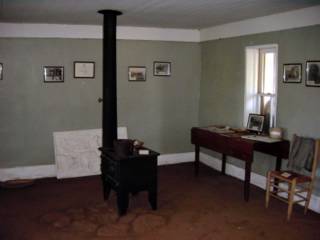
The Red River - Border between Texas and Oklahoma.
Photo by elderbob.

Doan's Camp, was the crossing point from Texas to Oklahoma for estimates of long horn cattle as high as 6 million head. This would be the largest amount of cattle crossing at any one point on the Red River. Of the original buildings at Doan's only this adobe home still stands. It has been restored and still retains it's original dirt floors.

Inside of Doan's Camp....Oldest building in county. Note original dirt floor.
Photo by Elderbob



2 comments:
Thanks to the Bandera Trail Riders who came to Doan's Crossing in May 2004 for the Western Trail ceremony. I must say, though, I've never heard it called Doan's Camp in my lifetime (graduated from Amarillo High in 1961). Corwin and Lide Doan, my Great-Grandparents were the original Doan's Crossing settlers. They were invited to come settle by Quanah Parker, the Great Comanche War and Medicine Chief, who had agreed to surrender in the Battle of Palo Duro Canyon. The Texas Rangers had found a way into the Canyon where the Comanches were wintering, and slaughtered the horses and people. Quanah stopped the event, saying that everyone would be dead if he did not. (When little, I always thought Quanah was an uncle.) Bertha was brought from Ohio in the wagon as about a 1 yr old baby, and was the first white/non-Comanche baby in the County, as I've always heard. My Grandmother, Mabel, was the 2d white/non-Comanche baby born in the county. As a tiny girl, I spent most of my first 9 years at Doan's, mostly with Grandma, and treasured every minute. If she ever saw the picture of her immaculate house on this website, put back to a dirt floor, she'd have a fit. Her upright piano stood in a corner to the left, facing the stove in the center. Her "Whatnot"--a beautiful cabinet of treasured things--stood right by the front door. A dining room and kitchen had been added onto the back, in which were a formal dining table and "sideboard", with sterling silver for special days. The refrigerator ran on butane, I believe. There was no running water when I was little, but my Grandfather, C.W. Igou, put it in before Mable passed away after a long battle with cancer. That's enough for now, but wanted everyone to know that this restoration was evidently conceived to put it back in the 1800's. I have many of the family things, but still work for the Army so have never slowed down. Thanks.
Thanks to the Bandera Trail Riders who came to Doan's Crossing in May 2004 for the Western Trail ceremony. I must say, though, I've never heard it called Doan's Camp in my lifetime (graduated from Amarillo High in 1961). Corwin and Lide Doan, my Great-Grandparents were the original Doan's Crossing settlers. They were invited to come settle by Quanah Parker, the Great Comanche War and Medicine Chief, who had agreed to surrender in the Battle of Palo Duro Canyon. The Texas Rangers had found a way into the Canyon where the Comanches were wintering, and slaughtered the horses and people. Quanah stopped the event, saying that everyone would be dead if he did not. (When little, I always thought Quanah was an uncle.) Bertha was brought from Ohio in the wagon as about a 1 yr old baby, and was the first white/non-Comanche baby in the County, as I've always heard. My Grandmother, Mabel, was the 2d white/non-Comanche baby born in the county. As a tiny girl, I spent most of my first 9 years at Doan's, mostly with Grandma, and treasured every minute. If she ever saw the picture of her immaculate house on this website, put back to a dirt floor, she'd have a fit. Her upright piano stood in a corner to the left, facing the stove in the center. Her "Whatnot"--a beautiful cabinet of treasured things--stood right by the front door. A dining room and kitchen had been added onto the back, in which were a formal dining table and "sideboard", with sterling silver for special days. The refrigerator ran on butane, I believe. There was no running water when I was little, but my Grandfather, C.W. Igou, put it in before Mable passed away after a long battle with cancer. That's enough for now, but wanted everyone to know that this restoration was evidently conceived to put it back in the 1800's. I have many of the family things, but still work for the Army so have never slowed down. Thanks. Doan Igou Lusk
Post a Comment